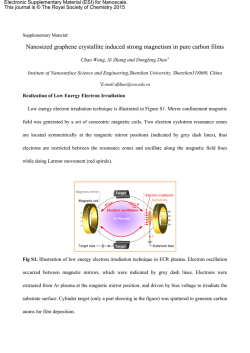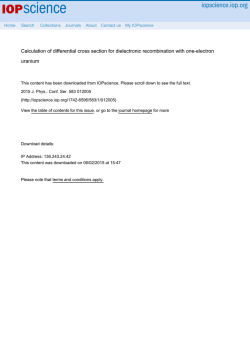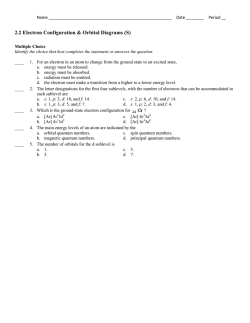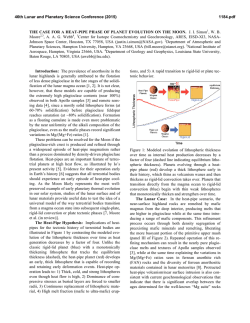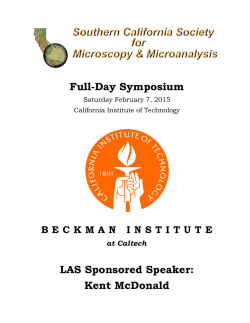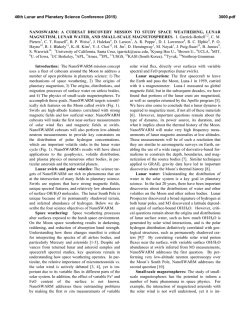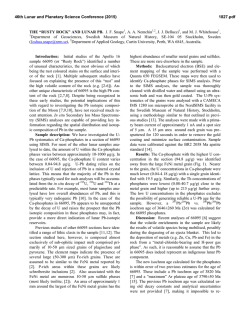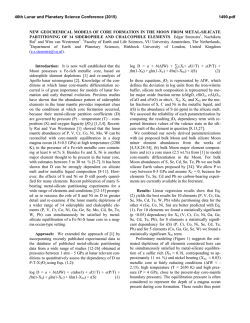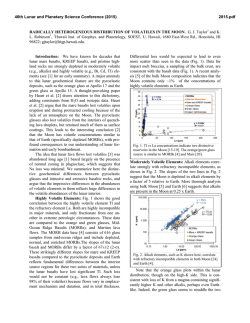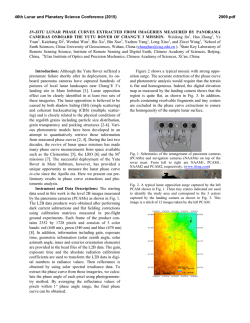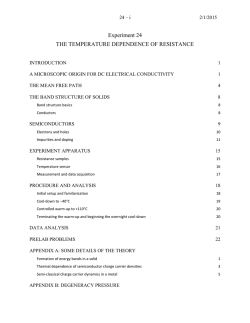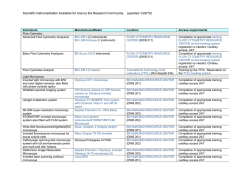
Secondary Electron Yields from Lunar Soil Due to Low Energy
46th Lunar and Planetary Science Conference (2015) 2883.pdf SECONDARY ELECTRON YIELDS FROM LUNAR SOIL DUE TO LOW ENERGY ELECTRON IMPACT. C. A. Dukes, C. Bu, and R. A. Baragiola, University of Virginia, Laboratory of Atomic and Surface Physics, Charlottesville, VA 22904, USA [[email protected]]. Introduction: Charging of the lunar surface is governed by time-varying fluxes of electrons and ions from the solar wind, photoelectrons ejected by UV photons, cosmic rays, and micrometeorite impacts. Moreover, site-specific lunar surface charge is also a function of soil composition, local soil topography, and the orography of the region. Lunar surface potential measurements, due to photoelectron emission and plasma currents, range from ~+10V to -4 kV with respect to the surrounding plasma. On average, the lunar surface potential is positive over most of the sunlit hemisphere, due to the dominance of photoelectric emission from solar radiation [1]. This was confirmed by dayside SIDE (Suprathermal Ion Detector Experiments) measurements during the Apollo 12, 14, and 16 missions [2]. On the night side, the potential is negative, with values ranging from -10 to -100 V to several kilovolts when the Moon enters the energetic plasma environment of the terrestrial magnetotail or during energetic particle events [3,4]. Modeling microscopic charging of airless bodies requires detailed calculations of photon and charged particle induced electron emission. Therefore, the characterization of electron impact on bulk lunar materials is important, and measurement of critical parameters such as secondary electron yields and energy distributions is vital to our understanding of the charging process. Artemis electron energy distribution measurements at the lunar surface show that most electrons near the lunar surface are less than 200 eV [4]. This flux of low energy electrons is derived from a combination of sources: photoelectrons ejected from the lunar soil, solar wind electrons (typ. ≤ 10 eV), secondary electrons from solar wind and cosmic ray ion impact, and electrons of magnetospheric origin [5]. Experiment: We investigate electron emission from two lunar highland soils of varied maturity. Our first sample, Apollo 16 sub-mature (Is/FeO = 47.0), lunar highland soil 61241, has a particularly low glass content, 3.3%. Yield from a second sample, mature (Is/FeO = 91.0) highland Apollo 62231, is analyzed for comparison. For measurement of the total secondary electron yield (σ), a special 304 stainless steel cup is designed to hold the lunar soil (Fig. 1), similar to the type used in our previous work [6]. The sample cup is electrically isolated by an insulating spacer from a stainless steel collection cap with a small (~1mm) aperture to admit primary electrons. Additional rings suppress the escape of secondary electrons through the cap aperture. We note that the electron angle of incidence is unimportant, since secondary electron emission from rough samples is insensitive to the average angle of incidence. Electron yield experiments are conducted in a custom ultra-high vacuum chamber (base pressure: ~10-10 Torr) equipped with an electron energy loss spectrometer (EELS). The low-energy (1 - 200 eV), monoenergetic, electron gun from the EELS system is utilized as an electron source for these experiments. Beam currents are typically < 500 pA. The primary electron beam is pulsed using a Directed Energies, Inc. +/- 1 kV pulser and may be deflected into and away from the sample cup. Electron pulse length onto the lunar soil may be varied from 50 ns to DC, controlled via an input gate. Fig. 1. Device for the collection and measurement of absolute secondary electron yields. The total electron yield, σ, for a material is defined as the number of electrons emitted per incident electron and is derived from two components: 1) secondary electrons, which include all electrons ejected with energies ≤ 50 eV and 2) backscattered primary or rediffused electrons with energies ≥ 50 eV. To extrapolate the total electron yield, we measure the current induced on the lunar soil cup Is and the corresponding electron current on the positively biased collection cap, Ic . The measured soil current Is is equivalent to the incident primary electron current Io minus the current due to backscattered and secondary electrons, such that: Is = Io - Ic, where the current on the collection cap is Ic = Ioσ. A correction is made to Is and Ic to account for leakage through the insulator separating the cap from the sample holder and from ground. The total electron 46th Lunar and Planetary Science Conference (2015) yield is determined as: σ = Ic / (Is + Ic). Electron yields are measured as a function of time and fluence. Beam current on the cap is measured by a picoammeter (Keithley 6485) and that induced on the sample holder (Is) is measured by an electrometer (Keithley 6514). Both are recorded with a National Instruments 6009 analog input/output and computer. The electrometer and picoameter are calibrated against each other. A suppression ring is located above the collection cup to eliminate errors due to secondary electrons leaving through the aperture. Tertiary currents, such as backscattered electrons that hit the cap and are captured by the sample, are estimated to be a few percent. A grounded outer ring ensures that primary electrons are undeviated by electrostatic fields prior to entrance into the device. Discussion: Charging is usually not an equilibrium phenomenon, because of the temporal variations of the radiation environment and the slow response of trapped charges in insulators (which constitute the surface of most astronomical materials). However, an equilibrium can occur at the crossover energies: E’ and E,” where the surface charge changes polarity and σ = 1. Changes in surface potential due to continuous charging alter the energy at which the primary electrons strike the surface. If the charges are not compensated by conduction, the surface potential becomes increasingly negative for Ep > E” retarding incident electrons toward E”. For Ep < E’, the surface potential grows negatively up to the electron acceleration voltage, retarding incoming electrons toward zero kinetic energy. For energies between E' and E'', where the surface charge is positive under electron bombardment, continued irradiation causes the actual impact energy to increase with increasing surface charge, shifting the bombarding electron energy toward E" and electron yield to one. This implies that, under continued electron impact and in the absence of leakage current, the long-term total electron yield should equilibrate at unity for all primary energies and the surface charge should appear neutral. Conclusion: We will report initial results of laboratory studies aimed at quantifying and understanding secondary electron emission and charging of bulk lunar soil under 1- 200 eV electron impact and identify relevant crossover energies for lunar soil in this energy regime. References: [1] Poppe, A. et al. (2011) GRL, 38, L02103; [2] Freeman, J. W. and Ibrahim, M. (1975) Moon, 14, 103; [3] Lindeman, R.A. et al. (1973) LPSC IV, 2889; [4] Halekas, J.S. et al. (2011) Planet Space Sci., 59, 1681; [5] Andregg, M. et al. (1972) Geochim. Cosmochim. Acta Supp. 3, 2665; [6] Dukes, C.A. and Baragiola, R.A. (2013) Planet Space Sci., 89, 36. 2883.pdf Acknowledgments: This work is supported through the NASA LASER program (NNX14AQ109).
© Copyright 2026
